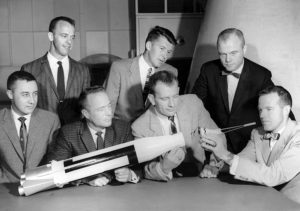 April 9, 1959 – Capt Virgil I. Grissom, Lt. Cdr Alan B. Shepard, Jr., Lt M. Scott Carpenter, Lt Cdr Walter M. Schirra, Jr., Major Donald K. Slayton, Major John H. Glenn, Jr., and Capt. L. Gordon Cooper are chosen as the Mercury 7.
April 9, 1959 – Capt Virgil I. Grissom, Lt. Cdr Alan B. Shepard, Jr., Lt M. Scott Carpenter, Lt Cdr Walter M. Schirra, Jr., Major Donald K. Slayton, Major John H. Glenn, Jr., and Capt. L. Gordon Cooper are chosen as the Mercury 7.
Shepard became the first American in space by making a suborbital flight in May 1961.[140] He went on to fly in the Apollo program and became the only Mercury astronaut to walk on the Moon.[141] Gus Grissom, who became the second American in space, also participated in the Gemini and Apollo programs but died in January 1967 during a pre-launch test for Apollo 1.[142] Glenn became the first American to orbit the Earth in February 1962, then quit NASA and went into politics, serving as a US Senator from 1974 to 1999, and returned to space in 1998 as a Payload Specialist aboard STS-95.[143] Deke Slayton was grounded in 1962, but remained with NASA and was appointed Chief Astronaut at the beginning of Project Gemini. He remained in the position of senior astronaut, in charge of space crew flight assignments among many other responsibilities, until towards the end of Project Apollo, when he resigned and began training to fly on the Apollo-Soyuz Test Project in 1975, which he successfully did.[144] Gordon Cooper became the last to fly in Mercury and made its longest flight and also flew a Gemini mission.[145] Carpenter’s Mercury flight was his only trip into space. Schirra flew the third orbital Mercury mission and then flew a Gemini mission. Three years later, he commanded the first crewed Apollo mission, becoming the only person to fly in all three of those programs.
One of the astronauts’ tasks was publicity; they gave interviews to the press and visited project manufacturing facilities to speak with those who worked on Project Mercury.[146] To make their travels easier, they requested and got jet fighters for personal use.[147] The press was especially fond of John Glenn, who was considered the best speaker of the seven.[148] They sold their personal stories to Life magazine which portrayed them as patriotic, God-fearing family men.[149] Life was also allowed to be at home with the families while the astronauts were in space.[149] During the project, Grissom, Carpenter, Cooper, Schirra and Slayton stayed with their families at or near Langley Air Force Base; Glenn lived at the base and visited his family in Washington DC on weekends. Shepard lived with his family at Naval Air Station Oceana in Virginia.
Other than Grissom, who was killed in the 1967 Apollo 1 fire, the other six survived past retirement[150] and died between 1993 and 2016.
Source: Wikipedia
